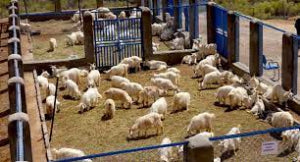
Pashmina Goat Farming and its Impact on the Economy
Share
Introduction
Pashmina, often referred to as the "Diamond Fiber" or "Soft Gold," is renowned for its luxurious texture and warmth. This exquisite textile is derived from the fleece of the Pashmina goat, also known as the Changthangi goat. The art of Pashmina goat farming has been a vital economic driver in regions like Kashmir, Nepal, and Tibet for centuries. In this blog, we will delve into the world of Pashmina goat farming and explore its profound impact on the economy.
The Pashmina Goat - A Jewel of the Himalayas
Pashmina goats are indigenous to the harsh and unforgiving terrain of the Himalayan region, where they have adapted to extreme weather conditions. These goats are a source of pride for the people of this region and are often considered a symbol of wealth and prosperity.

also read: a detailed blog on how much is a cashmere goat worth
The Art of Pashmina Goat Farming
Breeding and Rearing
The journey of Pashmina begins with careful breeding and rearing of these special goats. Pashmina goats are small in size and have a distinctive appearance with long, fine, and soft undercoats. Their rearing involves providing them with a balanced diet and shelter from the extreme cold.
Shearing and Collection
The fleece of Pashmina goats is collected through shearing, which is typically done in the spring when the goats naturally shed their winter coats. This process is carried out with great care to ensure the highest quality of Pashmina fiber. Each goat yields a small amount of fleece, making Pashmina a rare and precious material.
Economic Significance of Pashmina Goat Farming
Employment Opportunities
Pashmina goat farming plays a pivotal role in generating employment opportunities in remote Himalayan regions. Many families depend on this industry for their livelihoods, from shepherds who care for the goats to skilled artisans who craft Pashmina garments.
also read: a detailed blog on empowering women through GI pashmina shawls
Export and Revenue Generation
The global demand for Pashmina products, including shawls, scarves, and blankets, has been steadily increasing. This demand fuels the export of Pashmina goods, contributing significantly to the economy of the regions where these goats are bred. The revenue generated from Pashmina exports is crucial for the overall development of these areas.
Tourism Boost
Pashmina goat farming has also given rise to a unique form of tourism known as "Pashmina tourism." Travelers from around the world visit Pashmina-producing regions to witness the entire process, from goat farming to the creation of luxurious Pashmina garments. This form of tourism not only provides additional income but also raises awareness about the importance of preserving Pashmina goats.
Challenges and Conservation Efforts
Climate Change
Climate change poses a significant threat to Pashmina goat farming as it can disrupt the fragile ecosystem of the Himalayas. Rising temperatures and unpredictable weather patterns can impact the goats' health and the quality of their fleece.
Overgrazing and Habitat Loss
Overgrazing and habitat loss due to expanding human settlements are additional challenges. These issues can lead to a decrease in the population of Pashmina goats and a decline in the quality of their fleece.
To address these challenges, various conservation efforts have been initiated, including sustainable grazing practices and community-based wildlife conservation programs.
Pashmina - A Sustainable Luxury
Pashmina goat farming not only supports local economies but also promotes sustainability in the fashion industry. Pashmina garments are known for their longevity and timeless appeal. Unlike fast fashion, Pashmina products are cherished for generations, reducing the overall environmental impact of textile production.
Conclusion
Pashmina goat farming is a remarkable practice deeply intertwined with the economy of Himalayan regions. It sustains livelihoods, fosters economic growth, and promotes sustainable fashion. However, it also faces challenges that require collective efforts to ensure the continued prosperity of Pashmina goat farming and the preservation of this precious natural resource. As consumers, recognizing the value of Pashmina and its impact on these communities can lead to more responsible choices in the world of luxury fashion. By supporting Pashmina, we not only embrace its luxuriousness but also contribute to the well-being of the people and the environment in the Himalayas




